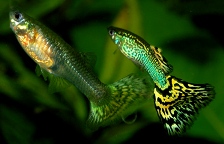Guppy
(Poecilia Reticulata)
Alternate Names:
Fancytail
Millions Fish
Rainbow Fish
 Guppy (Poecilia Reticulata) |
Size: 2.5 inches Temp Range: 78°F to 82°F pH Level: 7.0 to 8.5 Lifespan: 2 to 4 years Tank Size: 10 gallons Diet: Pellet, Flake, Frozen Difficulty: Very Easy |
Geographic History
These colorful little guys are native to Antigua and Barbuda, Barbados, Brazil, Guyana, Jamaica, The Netherlands Antilles, Trinidad and Tobago, U.S. Virgin Islands, and Venezuela.
Enviornment
Rule number one about guppies is that you must keep good water quality. They are a small fish with small organs. This makes them very sensitive to harmful chemicals.
They like to have plants to hide and spawn in. You should plant the sides and rear of your aquarium to give them some cover. Use smooth decor to avoid fin damage. Their long flowing tail fins can snag on on sharp edges.
Be sure you leave plenty of open water swimming room in the middle of your aquarium. These are active little fish and they love to school in the open.
Compatibility
Guppies are very docile fish. The males may show aggression to other male guppies and fish of the same size when there are to few females in the aquarium. Keeping three to four females for each male reduces the chance of a Guppy fight.
Do not keep with known fin nippers. The long tail fins of the males are just to much of a temptation for fish like Tiger Barbs. Large Cichlids should not be kept with them either. Guppies make a great lunch for fish like Jack Dempsey and Oscar.
Also, you should not have Betta in the aquarium with these little guys. They will mistake them for juvenile male Betta and kill them.
Sexing
Males have longer and much wider tail and dorsal fins. The bodies of males are also usually more colorful than the females. The Guppy female has a fatter belly and a dark gravid spot can be seen when they are pregnant. The females may also appear larger than the males.
Behavior
Guppies are schooling fish that can be seen shoaling in open water when kept in groups of six or more. Groups should be heavy with females and only one to three males should be kept in the aquarium. Be sure to have three to four females for each male. If you have to few females, the males will fight and chase the females in a constant effort to spawn. This stress will kill most of your Guppies.
At feeding time, these little guys are enthusiastic eaters. They will take crushed pellets, flake, and small bits of frozen food. They also spend a fair amount of the day grazing around the bottom for bits of uneaten food, when they are not trying to spawn.
Breeding
This may be the easiest of all tropical fish to breed. They will spawn right in a community aquarium if there are plenty of tall plants for cover. The females carry the eggs inside their bodies and give birth to live, swimming fry. You will be able to see a dark gravid spot inside the belly of the female when she is pregnant.
If your aquarium has many fine leafed plants, the fry will hide among them and many will survive. The parents and other fish will eat the fry, but you may need the crowd control. The females give birth to hundreds of fry at a time and can continue to do so every few days after one spawning. The females will store sperm after a single spawning to fertilize eggs for many weeks.
If you have a dedicated breeding tank, you should remove the male after spawning occurs. Use a small tank divider to keep the female Guppy away from the fry and she will have another batch in a few days. It may be hard to isolate her again, so remove the female after the second set of fry are born.
Fry are born free swimming and will feed on crushed flake and baby brine shrimp. Keep excellent water quality by doing 10% daily water changes, being careful not to suck the fry out with the old water. Be prepared for hundreds of juvenile Guppies if you breed these fish outside of a community tank.
For more information, go to Wikipedia's Guppy page.





